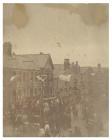Denis Belamy Story
Eitemau yn y stori hon:
Came to Wales
I first came to Wales in 1969 to take up the Chair of Zoology in the University of Wales’ College of Cardiff. At that time, Cardiff was one of seven relatively small collegiate institutions making up the University of Wales. Cardiff had around 4,500 students.
Because of the spread of its colleges throughout Wales, the University of Wales senate used to gather in Shrewsbury castle and its Committees met in the Great Western Hotel at Paddington Station.
Expansion and independence were in the air, even in the 1970s. After my appointment Principal Bevan showed me a map on the wall of his office, which delineated plans for the growth of the college to a university of 9,000 students by 1990. There was also talk of a merger with the University of Wales Institute of Science and Technology (UWIST) across the road, This did not take place until 1988, and on the way, the Llandaff College of Education (Home Economics) was absorbed. In 1999 the public name of the University changed to Cardiff University and five years later there came a merger with the University of Wales College of Medicine.
In December 2004 the Privy Council approved a new Supplemental Charter granting university status to the greatly enlarged higher education body in Cardiff. The legal name changed to Cardiff University. The university had finally gained independence from the University of Wales.
Now, nearly fifty years after I came to Wales I am still living in Cardiff as Professor Emeritus of an independent University of Cardiff.
Cardiff is currently (2016) ranked 5th amongst UK universities based on quality of teaching and research, and is a member of the Russel Group, a selection of 24 leading UK research intensive universities. Cardiff is now the 8th largest university in the UK with about 30,000 students from 100 different countries, with a total estimated income of 500M from research contracts. Such has been the development and growth of British Universities since the 1960s.
There is much that signifies historical attitudes towards education locked into the timeline of name changes in educational organisations and the subjects they teach. Up until the 1960s there were two outposts of the University of Wales in Cardiff; the College of Medicine and the University College of South Wales and Monmouthshire. The latter name reflects the ambivalent political attitude of ‘South Walians’ to towards England: is Monmouthshire a part of Wales? Indeed, University College had, from its inception in 1888, served mainly Cardiff and the South Wales Coalfield. In the 1970s, round 40% of my students came from the Valleys and the rest were mainly English. There was an Old Zoologists Association consisting of local retired teachers and ‘scientific servants of Empire’, which met annually to be addressed by the head of department on current developments in the department This gradually faded away with the death of a pre War generation of students and an increased intake of young people from across the borders Today Cardiff University is very proud of its international student body.
At the time I moved to Cardiff change was also afoot in both curricula and pedagogy. With respect to animal science, the department had just had a name change from the Department of Zoology and Comparative Anatomy, to being simply the Department of Zoology. This reflected a general trend to stress the similarities of all living things as opposed to studying the structural differences between them. The major similarities lie in their biochemistry and this had been the subject of my DPhil research in Oxford. Working in Sir Hans Krebs department I confirmed the structural and functional unity of the pathways for energy production by intracellular structures called mitochondria, I was able to isolate these organelles from a range of animals, from mammals to flies, and demonstrate that they all contained the same basic chemical cycles for energy production . Hans Krebs was a Nobel Laureate and his research in the 1930s led to a complete understanding of the chemistry of energy production. My small additional contribuition was to provide evidence of how these reactions were closely integrated within the mitochondria.
Biochemistry was developing at great speed. When I began my undergraduate studies, departments of biochemistry had just been invented and little was understood about how food could be converted to energy. During my final year at Oxford, Watson and Crick visited the department to talk about the structure of DNA and the modus operandi of gene expression through the coding of protein synthesis . In my six years from undergraduate to postgraduate, the principles of biochemistry had been well and truely established. Travelling this pathway coincided with many developments in the tools required for taking cells apart to unravel their inner workings; some examples are flame photometry, gas chromatography, electron microscopy, oxygen/sodium electrodes, use of radioisotopes as biochemical markers, autoanalysers and electron microscopes. I have used all of them at one time or another.
I am not partial to ‘wars of attrition’ in research and the prospect of staying with biochemistry to unravel the minutia of what is known as intermediary metabolism, did not appeal and I moved towards the next great biochemical unknown, which is the question of how cells function in organs. I describe this concept as ‘cellular ecology’ where populations of cells in organs communicate with one another through the medium of circulating hormones. Cellular ecology is not only at the heart of the action of hormones but also underlies medical problems such as cancer, and aging. The latter two biomedical fields were to dominate my research in Cardiff, which focused on the central question, how does an organ know the size it should be at any particular age? The question is still unresolved.
After a year as Krebs’ post doctoral teaching assistant I was asked to join the zoology department in Sheffield, which was an international centre for research into how hormones of the vertebrate adrenal glands control organ function and what goes wrong in diseases such as Addison’s disease. Hormones are important agents in adaptations of animals to their environment and this led me to ecology and evolution because it is not the hormones that evolve but the uses to which they are put I spent nine years in Sheffield, emerging as more of a zoologist than a biochemist, then, as Reader in Endocrinology and Metabolism, I moved to the University of Wales to take on the zoology department in Cardiff.
My aims
I had three aims in making the move to Wales, which were all related to the central theme of ‘ecosystem’ as my interdisciplinary focus of teaching and research.
I have already said that I was beginning to explore the concept of ‘cellular ecology’,in Sheffield, Now, with a grant from the Cardiff TENOVUS medical charity I was able to begin exploring the mammalian thymus gland to understand the factors controlling its size and shape. It has a very high rate of cell division of the lymphocytes which comprise most of its mass yet it maintains a definite size and shape in relation to age. However, I could have pursued this problem of ‘cellular ecology’, and its relationship to ageing, anywhere in the world.
What came specifically into a Welsh focus was ‘species ecology’ and the relationship between biodiversity and the human ecological niche. This was exemplified in South Wales by the landscape-scale dereliction resulting from extraction of coal and metal working. In the mid 1960s ecologists became aware of the contribution they could make to solve the special environmental problems by creating new habitats. Habitat creation as a distinct ecological movement can be traced to the choice of the topic of 'Ecology and the Industrial Society' by the British Ecological Society for its fifth symposium, held at the University College of Wales, Swansea, in 1964. The organisers of the Swansea conference felt that ecologists had something important to offer in the recognition, analysis and solution of these problems. My department played a significant role in cleaning up the rivers Taff and Rhondda.
Picking up on this I could see that an entirely new approach to education for behaviour change, stressing the relationships between culture and ecology, was required at all levels .I began this task in Cardiff by promoting environmental studies, with contributions from departments as diverse as archaeology, metallurgy and zoology, within the general honours degree. Eventually, as a consultant to the University of Cambridge a cross-curricular subject called 'natural economy' was produced, which dealt with world development. This was promoted by the Cambridge University Local Examination Syndicate as an international GCSE.
With the help of a grant from the Education Directorate of the European Union 'natural economy' was developed on line as 'cultural ecology'. The cultural ecology web sites, wikis and mindmaps currently receive about a million worldwide visits a year.



